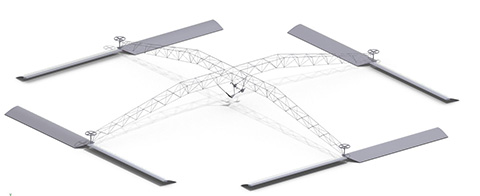Pilot Briefing
News from the world of general aviation
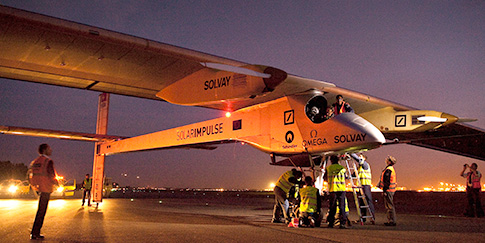
Solar Impulse makes international flight
Bertrand Piccard and André Borschberg are a step closer to their goal of circling the Earth, nonstop, in a solar-powered airplane. In May, the delicate craft flew from Switzerland to Brussels, Belgium. The aircraft flew 340 nm in 13 hours at 27 knots.
NOTICE OF ANNUAL MEETING OF MEMBERS
The annual meeting of the members of the Aircraft Owners and Pilots Association will be held at 12 noon on Friday, September 9, 2011, at the headquarters of AOPA, 421 Aviation Way, Frederick, Maryland, 21701, located on Frederick Municipal Airport (FDK), for the purpose of receiving reports and transacting such other business as may properly come before the meeting, including the election of trustees. —John S. Yodice, Secretary
There are still a few steps remaining, big ones, like the development of the final record challenger aircraft (similar to the one flying now) and transoceanic flights. Yet the present craft has done everything asked of it, including flying all night on battery power alone. It intends to circle the globe by climbing and recharging its batteries during the day, slowly descending on battery power at night, bobbing among altitudes like a yo-yo until it has circumnavigated the world.
The craft departed the Payeme aerodrome in Switzerland; crossing Alsace and Nancy, then Metz, France; before overflying Luxemburg and arriving at Brussels Airport. It has no other form of power aside from solar cells and batteries. A satellite communication system kept the pilot in touch with Payeme.
André Borschberg was at the controls and flew most of the time at 6,000 feet. “It’s a spectacular flight,” he said afterward. “The takeoff was a little challenging because we had to rush because of air traffic activity; consequently, I needed a little bit of time to get everything in order before I could become serene. It was little bit northeast wind during takeoff; however, this was not a major problem.”
Explorer High Country sneaks into marketplace
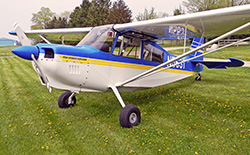 American Champion Aircraft of Rochester, Wisconsin, says it has sold four of the 180-horsepower High Country tandem-seat tailwheel aircraft since last Thanksgiving, quietly resuming production that ended last year when engines were unavailable.
American Champion Aircraft of Rochester, Wisconsin, says it has sold four of the 180-horsepower High Country tandem-seat tailwheel aircraft since last Thanksgiving, quietly resuming production that ended last year when engines were unavailable.
The aircraft has reemerged with a Lycoming O-360-C4P engine. The aircraft was the first to offer the Superior Air Parts Vantage engine, but production of that engine stopped when Superior Air Parts entered bankruptcy. There are plans to restart the Superior line, but in the meantime, American Champion has switched to Lycoming.
While the base price is $148,900, the aircraft sold so far go out the door at about $168,000. The aircraft photographed in May for this article is priced at $171,756.
Officially, the High Country is part of the Explorer line. Compared to a straight Explorer, the High Country has 20 more horsepower, a larger-diameter propeller, and the propeller requires slightly larger tires for ground clearance.
Say Again?
Test yourself with these aviation quiz questions
By AOPA Pilot staff
See answers below
Memorable mottos and marketing campaigns by mostly forgotten airlines:
- What Golden State carrier offered school children $25 flights to Sacramento for field trips that included tours of the state legislature, governor's mansion, and Sutter's Fort?
- What airline formerly owned by Howard Hughes flew yellow airplanes and called itself the "Top Banana in the West"?
- What airline (subsequently purchased by Southwest Airlines) banned smoking long before federal regulations required it?
- What DC–9 operator gave passengers in the Big Apple bags of tasty treats known as the "flying nosh"?
- What airline (which subsequently merged with TWA) hired comedian George Carlin as a pitch man?
- This airline made light of some passengers' fear of flying by handing out "survival kits" that included a security blanket, rabbit's foot, and a copy of the best-selling book The Power of Positive Thinking.
- This airline's jets were painted with smiles ("Catch Our Smile") and the carrier called itself "The World's Friendliest Airline."
- This airline billed itself as the "Route of Aristocrats."
- This airline served free champagne to adult passengers and called itself "The Champagne Airline."
A major commute
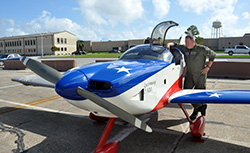 Very few pilots use a personal aircraft for commuting to and from work, but that was the case for U.S. Air Force Maj. Ben Cook of the 95th Fighter Squadron at Tyndall Air Force Base, Florida. As you read this he is serving in Afghanistan.
Very few pilots use a personal aircraft for commuting to and from work, but that was the case for U.S. Air Force Maj. Ben Cook of the 95th Fighter Squadron at Tyndall Air Force Base, Florida. As you read this he is serving in Afghanistan.
Cook's day job while in the United States was an instructor pilot for the Boeing F–15 Eagle strike fighter. To get to work, he used a Glasair painted red, white, and blue with white stars. He talked about his ride somewhat reluctantly, concerned that people would think he was tooting his own horn. "I know that showing how GA can benefit in different ways is always a good thing," Cook said by email from Afghanistan. "The Glasair has been a great little airplane as a commuter. I usually get about 148 KTAS at a fuel burn of 7.8 gph or so."
He lived in Pensacola while based in Florida. He faced several choices. He could live apart from his wife, Jen, to be near the base, drive three hours, or make a 40-minute flight. The airplane won.
"I flew to work every day," said Cook. "The ride gives me time to relax going to and from work. For gas alone, it's actually cheaper."
He lived five minutes from the hangar in Pensacola. Unless there was severe lighting or thunderstorms, he always flew to work.
"This is the first aircraft I've owned and I flew it to work from October 2009 through most of 2010," Cook said. Other instructor pilots reported they were a bit jealous of the convenience Cook experienced, not to mention the fun.
"I take my wife, family, and friends up in the aircraft as often as I can," Cook said. "If my wife and I go on vacation within 1,000 miles of our home, we fly there in my plane. It gives us the opportunity to go on trips a lot."
Cook is nearly finished with his tour in the Middle East. Upon his return, he and his wife plan to move to Louisiana, where he intends to join the Air National Guard.
They did it
Engineering students at the University of Maryland built a human-powered helicopter that flew successfully for a few seconds—but more important, it was prior to graduation, just as they had hoped. Two other teams, one of them in Japan, have achieved liftoff for a few seconds, but since none of them has claimed a world record, the University of Maryland has filed with the National Aeronautic Association for one. The gangly craft, named Gamera after a giant flying turtle in a Japanese monster movie, lifted several inches off the ground.
It succeeded on an earlier attempt, but on the first flight a judge's camera was out of focus, so pilot Judy Wexler, 24, a 107-pound biology major and cyclist who volunteered for the attempt, once again had to flail furiously at foot pedals and a hand crank. She then
successfully hovered the 100-pound craft.
Still, the chief prize remains. More than 30 years ago, American Helicopter Society International set a goal of a human-powered helicopter that could hover at 10 feet for one minute. In 1980, Sikorsky Aircraft offered $20,000 for the achievement; increasing it to $250,000 two years ago after the University of Maryland announced it would pursue the prize.
It was fitting that the project was named for a turtle. The school mascot is a terrapin, and the school battle cry is "Fear the turtle."
Wexler, who pedaled 120 rpm to get the 43-foot rotors to turn at 18 rpm, was the first woman pilot to make the attempt, something that will stay in the record books even if a male pilot wins the Sikorsky award. Gamera was made of balsa, wood, foam, Mylar, and carbon fiber. The project has captured the commencement spotlight for the engineering team, and possibly and more important, a few job offers.
Community aids community, via light aircraft
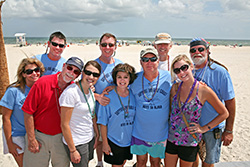 In 2010 communities surrounding the Gulf of Mexico saw their tourist trade devastated by the BP oil spill. An airport association group from the Birmingham, Alabama, area flew to Gulf Shores, Alabama, on August 17 for a day of spending like tourists as a show of support and a demonstration to the nation. (They had national media coverage.) Now Birmingham is devastated by tornadoes, and Gulf Shores citizens are helping their friends. General aviation airplanes are involved, once again.
In 2010 communities surrounding the Gulf of Mexico saw their tourist trade devastated by the BP oil spill. An airport association group from the Birmingham, Alabama, area flew to Gulf Shores, Alabama, on August 17 for a day of spending like tourists as a show of support and a demonstration to the nation. (They had national media coverage.) Now Birmingham is devastated by tornadoes, and Gulf Shores citizens are helping their friends. General aviation airplanes are involved, once again.
The Shelby County Aviation Association, normally a group of weekend $100-hamburger-hunting pilots plus nonpilot customers of the Shelby County Airport—located south of Birmingham—sent 22 aircraft and 66 people shopping for the day in Gulf Shores last year. "The area only gets by through tourism," said association president Andrew Ellis. "Some of us spent the entire weekend there." They planned to mark the one-year anniversary of their flight with a repeat flight to Gulf Shores, a one- to two-hour flight, to underscore that the Gulf has recovered. Then the tornadoes hit Birmingham on April 27.
On May 21, the fleet of aircraft from Alabaster, Georgia, the Birmingham suburb where Shelby County Airport is located, planned to visit Gulf Shores once again. This time it was to pick up toys for children in Birmingham who lost their homes. The pilots had T- shirts printed marking the recovery of the Gulf, and even though the purpose of the flight has changed, the shirts will still be worn. There were special shirts for the flight in 2010, too.
The aviation association was formed at a time when the Shelby County Airport was threatened. It has become a source of information for local and county government officials who are contemplating change in the operation or status of the airport. Top AOPA officials have visited with the successful association in the past.
Goodyear to replace three-blimp fleet
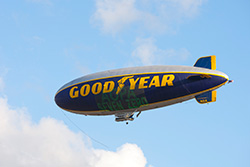 There isn't a more familiar flying machine anywhere than the Goodyear Blimp. Actually, there are three Goodyear blimps based in the United States: the Spirit of Goodyear in Akron, Ohio; the Spirit of Innovation in Pompano Beach, Florida; and the Spirit of America in Carson, California, as well as leased blimp operations in Europe and China.
There isn't a more familiar flying machine anywhere than the Goodyear Blimp. Actually, there are three Goodyear blimps based in the United States: the Spirit of Goodyear in Akron, Ohio; the Spirit of Innovation in Pompano Beach, Florida; and the Spirit of America in Carson, California, as well as leased blimp operations in Europe and China.
Major events attended by large crowds just wouldn't be the same without a Goodyear blimp overhead, providing aerial TV coverage and flashing messages on its electronic signs.
Now with the existing blimps nearing the end of their life cycles, Goodyear will "take the next evolutionary step in our airship program," said Nancy Jandrokovic, Goodyear's director of global airship operations.
On May 3, Goodyear announced a new pact with the German Zeppelin manufacturer ZLT Zeppelin Luftschifftechnik GmbH8coKG "to supply The Goodyear Tire & Rubber Company with airships well into the next decade."
The Zeppelin model LZ N07-101 airships will be built with teams from both companies at Goodyear's Wingfoot Lake Airship Hangar near Akron, Goodyear said. Construction of the first airship will start in 2013; it is expected to fly in 2014.
Goodyear said that the new airships will be 246 feet long, considerably larger than the current 192-foot-long blimps. Each zeppelin—which, unlike the blimps they replace, will have a rigid framework of aluminum and carbon fiber—is to be powered by three Lycoming IO-360 engines, and will "fly faster, carry more passengers, and include state-of-the art avionics and flight control systems." Each will cost about $21 million, including technical support.
Most Americans associate the word blimp with the name Goodyear. Products from Goodyear Aeronautics are associated with aircraft as far back as the Wright brothers.
"The Goodyear blimp is one of the most recognizable brand icons in the world. An event isn't considered truly special unless the Goodyear blimp is there to provide aerial coverage," said Richard J. Kramer, Goodyear chairman, CEO, and president. "I am pleased this investment will ensure that future generations will have the opportunity to experience the joy of seeing the Goodyear blimp grace the skies."
"We are extremely pleased to renew the Zeppelin connection with the famous Goodyear blimp program," said Thomas Brandt, CEO of ZLT Zeppelin Luftschifftechnik. "Goodyear and Zeppelin worked together almost 90 years ago to bring rigid airship technology to America and we're thrilled to be working together again." —Dan Namowitz
Say Again? Answers
- Air California (1967 to 1987)
- Hughes Air West (1968 to 1980)
- Muse Air (1981 to 1987)
- New York Air (1980 to 1987)
- Ozark Airlines (1950 to 1986)
- Pacific Air Lines (1946 to 1968)
- Pacific Southwest Airlines (1949 to 1988)
- Southern Airways (1949 to 1979)
- Western Airlines (1926 to 1986)
Do you have suggestions for quiz questions? Send your questions to [email protected].
Adam A500 aircraft to rise again
When Adam Aircraft was sold three years ago, the Russian company that bought it for $10 million said it would build the composite seven-seat A700 business jet, but ignore the six-seat A500 twin piston-engine model. Now, a new owner, Triton Aerospace, with offices in Anacortes and Burlington, Washington, has reversed the priorities.
The Russian firm, AAI acquisitions, went broke and sold the tooling, test rigs, plant equipment, aircraft, and a high-temperature curing facility to Triton America, then a real estate development company owned by Bayview Edison Industries. Bayview Edison was founded in 2005 to manufacture pleasure yachts (no longer built because of the recession) and composite tooling for marine and aerospace industries, including Epic and Viper Aircraft.
A new company was created in 2009 for the A500 under the same ownership and was named Triton Aerospace, the current owner of Adam Aircraft assets. All the companies are owned by Thomas Hsueh (pronounced shay), an aerospace engineer. Bayview Edison has become Triton Holdings, with ownership of Triton Aerospace and a new company, Bayview Composites, which makes tooling for large, heated wind-turbine blades.
A development site has been established in a building at Skagit Regional Airport, serving the Burlington and Mount Vernon, Washington, areas. The goal is to produce a prototype in two years, and work has started on the landing gear. While the basic shape of the aircraft will be retained, Hsueh hopes to remove 800 to 1,000 pounds from the aircraft. He owns businesses in China as well as Washington, and recently had three Chinese engineering interns at his plant to study the landing gear.
While no prototype is expected for two years, the schedule could be accelerated with the right facilities and funding. Much of the original Adam equipment is still in shipping containers. A six-person staff is currently working in the leased building at the Skagit airport to set up manufacturing facilities.
Piston models making a comeback
Piston-engine aircraft sales in the first quarter of 2011 did exactly what aerospace analyst Brian Foley said they would do—they went up by 22 deliveries compared to the first quarter of 2010.
Foley, reached at his office in Sparta, New Jersey, said piston sales will continue to improve throughout the year and will be "up smartly" by year-end. Piston-engine sales were the first to enter the recession in 2007 and are now the first to emerge, Foley said, commenting on new shipment numbers released by the General Aviation Manufacturers Association (GAMA).
Sales to individuals, which many piston-engine sales represent, are the "canary in the coal mine," Foley said. Individuals are the first to react to loss of wealth, and the first to act quickly, without waiting for the approval by a corporate board, when their personal wealth improves, he said. Foley cautioned not to be too excited about the 13.3-percent increase in piston engine sales. "A double-digit portion of a really small number is still a small number," he said.
Piston-engine sales are expected to precede the return of the jet market by a year. Overall, piston-aircraft sales worldwide climbed from 166 in the first quarter of 2010 to 188 for the same period in 2011. Turboprops declined from 60 in 2010 to 56 this year, while business jets declined from 164 to 128.
In the United States, piston-engine sales climbed during the first quarter from 131 deliveries in 2010 to 149 in 2011. Turboprops increased by only one delivery, from 38 to 39, as did business jets, climbing from 74 to 75. Airplane shipments in North America climbed from 283 to 292, while shipments everywhere else in the world declined.
Looking at a few of the U.S. companies, first-quarter sales increased from eight to 13 at American Champion, from 80 to 106 at Cessna Aircraft, from 51 to 61 at Cirrus Aircraft, from 22 to 37 at Hawker Beechcraft, and from 18 to 29 for military deliveries at Hawker Beechcraft.
Cessna had no deliveries of the 350 Corvalis last year or this year, and no deliveries of the 400 Corvalis TT compared to one in the first quarter of 2010.
Piper sales declined from 30 to 26 aircraft, although deliveries were up for the Piper Seneca V, the Malibu Mirage, and the Meridian. Sales at Bombardier declined from 47 to 42, and from 17 to nine at Dassault Falcon Jet.
Embraer deliveries declined from 20 to eight, although Phenom 300 deliveries were up from one to four. Maule Air had one delivery in the first quarter of 2010, and one in the most recent quarter, while Mooney had two deliveries in 2010, but none this past quarter.
